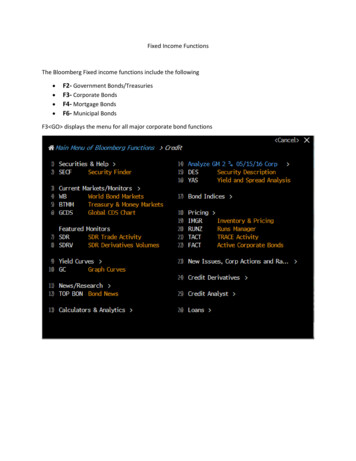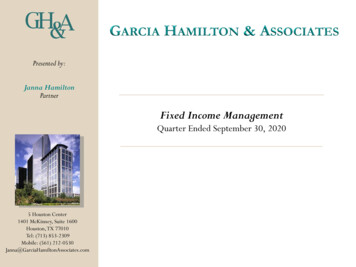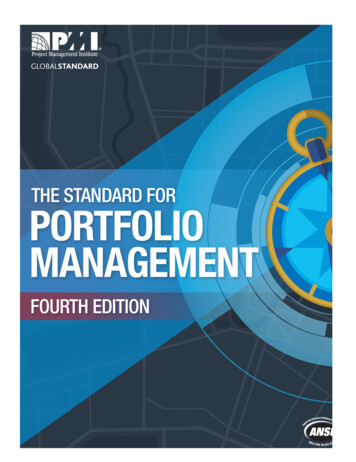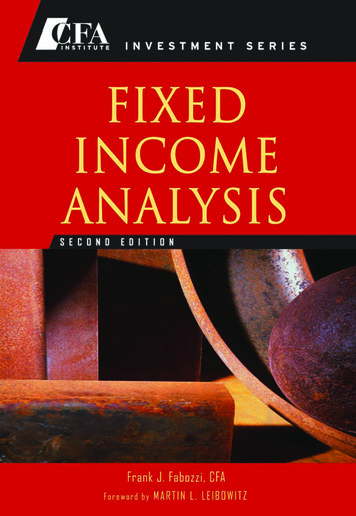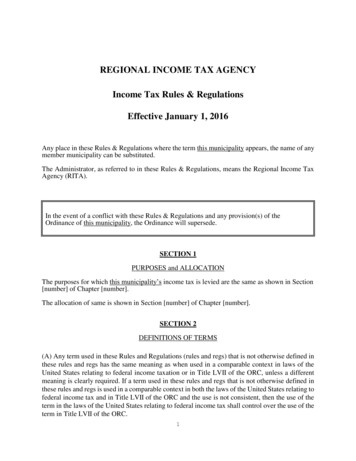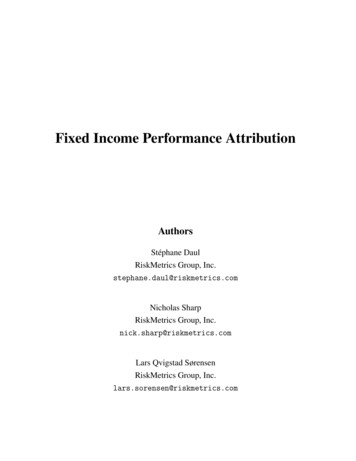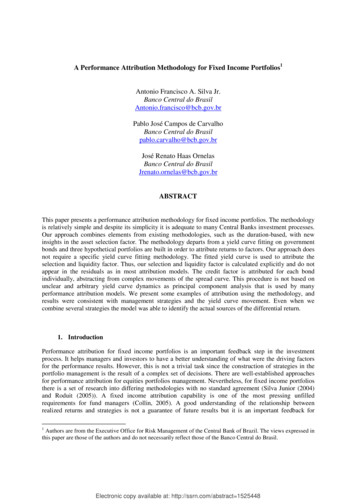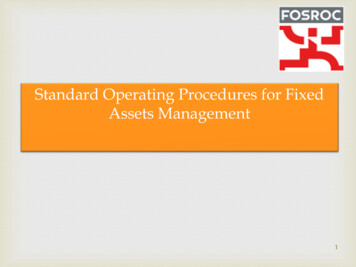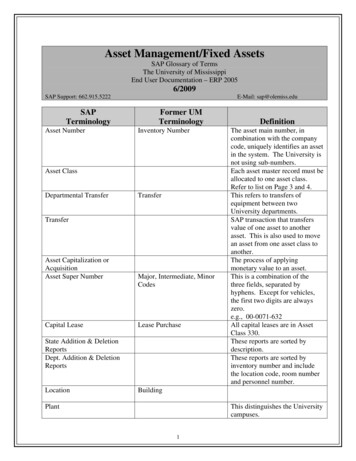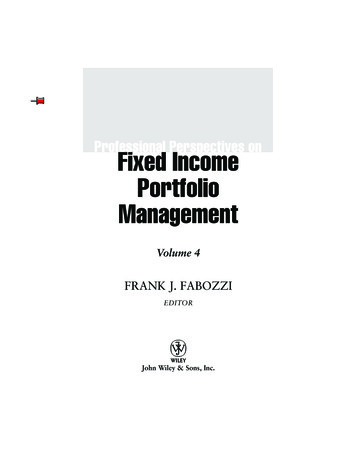
Transcription
Frontmatter-Prof Persp Page iii Thursday, July 24, 2003 10:09 AMProfessional Perspectives onFixed IncomePortfolioManagementVolume 4FRANK J. FABOZZIEDITORJohn Wiley & Sons, Inc.
Frontmatter-Prof Persp Page i Thursday, July 24, 2003 10:09 AMProfessional Perspectives onFixed IncomePortfolioManagementVolume 4
Frontmatter-Prof Persp Page ii Thursday, July 24, 2003 10:09 AMTHE FRANK J. FABOZZI SERIESFixed Income Securities, Second Edition by Frank J. FabozziFocus on Value: A Corporate and Investor Guide to Wealth Creation by James L.Grant and James A. AbateHandbook of Global Fixed Income Calculations by Dragomir KrginManaging a Corporate Bond Portfolio by Leland E. Crabbe and Frank J. FabozziReal Options and Option-Embedded Securities by William T. MooreCapital Budgeting: Theory and Practice by Pamela P. Peterson and Frank J.FabozziThe Exchange-Traded Funds Manual by Gary L. GastineauProfessional Perspectives on Fixed Income Portfolio Management, Volume 3edited by Frank J. FabozziInvesting in Emerging Fixed Income Markets edited by Frank J. Fabozzi andEfstathia PilarinuHandbook of Alternative Assets by Mark J. P. AnsonThe Exchange-Traded Funds Manual by Gary L. GastineauThe Global Money Markets by Frank J. Fabozzi, Steven V. Mann, andMoorad ChoudhryThe Handbook of Financial Instruments edited by Frank J. FabozziCollateralized Debt Obligations: Structures and Analysis by Laurie S. Goodmanand Frank J. FabozziInterest Rate, Term Structure, and Valuation Modeling edited by Frank J. FabozziInvestment Performance Measurement by Bruce J. FeibelThe Handbook of Equity Style Management edited by T. Daniel Coggin andFrank J. FabozziThe Theory and Practice of Investment Management edited by Frank J. Fabozziand Harry M. MarkowitzFoundations of Economic Value Added: Second Edition by James L. GrantFinancial Management and Analysis: Second Edition by Frank J. Fabozzi andPamela P. PetersonMeasuring and Controlling Interest Rate and Credit Risk: Second Edition byFrank J. Fabozzi, Steven V. Mann, and Moorad Choudhry
Frontmatter-Prof Persp Page iii Thursday, July 24, 2003 10:09 AMProfessional Perspectives onFixed IncomePortfolioManagementVolume 4FRANK J. FABOZZIEDITORJohn Wiley & Sons, Inc.
Frontmatter-Prof Persp Page iv Thursday, July 24, 2003 10:09 AMCopyright 2003 by Frank J. Fabozzi. All rights reserved.Published by John Wiley & Sons, Inc., Hoboken, New JerseyPublished simultaneously in CanadaNo part of this publication may be reproduced, stored in a retrieval system, or transmitted inany form or by any means, electronic, mechanical, photocopying, recording, scanning, or otherwise, except as permitted under Section 107 or 108 of the 1976 United States CopyrightAct, without either the prior written permission of the Publisher, or authorization throughpayment of the appropriate per-copy fee to the Copyright Clearance Center, Inc., 222 Rosewood Drive, Danvers, MA 01923, 978-750-8400, fax 978-750-4470, or on the web atwww.copyright.com. Requests to the Publisher for permission should be addressed to the Permissions Department, John Wiley & Sons, Inc., 111 River Street, Hoboken, NJ 07030, 201748-6011, fax 201-748-6008, e-mail: permcoordinator@wiley.com.Limit of Liability/Disclaimer of Warranty: While the publisher and author have used their bestefforts in preparing this book, they make no representations or warranties with respect to theaccuracy or completeness of the contents of this book and specifically disclaim any impliedwarranties of merchantability or fitness for a particular purpose. No warranty may be createdor extended by sales representatives or written sales materials. The advice and strategies contained herein may not be suitable for your situation. You should consult with a professionalwhere appropriate. Neither the publisher nor author shall be liable for any loss of profit orany other commercial damages, including but not limited to special, incidental, consequential,or other damages.For general information on our other products and services, or technical support, please contact our Customer Care Department within the United States at 800-762-2974, outside theUnited States at 317-572-3993, or fax 317-572-4002.Wiley also publishes its books in a variety of electronic formats. Some content that appears inprint may not be available in electronic books.For more information about Wiley, visit our web site at www.wiley.com.ISBN: 0-471-26805-4Printed in the United States of America10 9 8 7 6 5 4 3 2 1
Frontmatter-Prof Persp Page v Thursday, July 24, 2003 10:09 AMContentsPrefaceContributing AuthorsviixivFIXED INCOME ANALYSIS AND STRATEGIESRisk/Return Trade-Offs on Fixed Income Asset ClassesLaurent Gauthier and Laurie Goodman1Fixed Income Risk Modeling for Portfolio ManagersLudovic Breger17Tracking ErrorWilliam Lloyd, Bharath Manium, and Mats Gustavsson45Consistency of Carry Strategies in EuropeAntti Ilmanen and Roberto Fumagalli77The Euro Benchmark Yield Curve: Principal Component Analysis ofYield Curve DynamicsLionel Martellini, Philippe Priaulet, and Stéphane PriauletDollar Rolling—Does It Pay?Jeffrey Ho and Laurie Goodman103131CREDIT RISK AND CREDIT DERIVATIVESValuing Corporate Credit: Quantitative Approaches versus Fundamental AnalysisSivan Mahadevan, Young-Sup Lee, David Schwartz, Stephen Dulake,and Viktor HjortMaturity, Capital Structure, and Credit Risk: Important Relationships forPortfolio ManagersSteven I. Dym141183v
Frontmatter-Prof Persp Page vi Thursday, July 24, 2003 10:09 AMviContentsA Unified Approach to Interest Rate Risk and Credit Risk of Cash andDerivative InstrumentsSteven I. Dym197Implications of Merton Models for Corporate Bond InvestorsWesley Phoa211Some Issues in the Asset Swap Pricing of Credit Default SwapsMoorad Choudhry229Exploring the Default Swap BasisViktor Hjort239The Valuation of Credit Default SwapsRen-Raw Chen, Frank J. Fabozzi, and Dominic O’Kane255STRUCTURED PRODUCTSAn Introduction to Residential ABSJohn N. McElravey281Nonagency Prepayments and the Valuation of Nonagency SecuritiesSteve Bergantino303The Role and Performance of Deep Mortgage Insurance in Subprime ABS MarketsAnand K. Bhattacharya and Jonathan Lieber325Some Investment Characteristics of GNMA Project Loan SecuritiesArthur Q. Frank and James M. Manzi339A Framework for Secondary Market CDO ValuationSivan Mahadevan and David Schwartz365Understanding Commercial Real Estate CDOsBrian P. Lancaster395Aircraft Valuation-Based Modeling of Pooled Aircraft ABSMark A. Heberle431Index439
Frontmatter-Prof Persp Page vii Thursday, July 24, 2003 10:09 AMPrefacehe articles in volume 4 of Professional Perspectives on Fixed IncomePortfolio Management are grouped into three areas: Fixed Income Analysis and Strategies, Credit Risk and Credit Derivatives, and StructuredProducts.TFIXED INCOME ANALYSIS AND STRATEGIESIn the lead article in this volume, “Risk/Return Trade-Offs on Fixed IncomeAsset Classes,” Laurent Gauthier and Laurie Goodman look at the risk/return characteristics of major fixed-income asset classes over time in orderto see if one asset class consistently outperforms another on a risk-adjustedbasis. They first look at the Sharpe ratios for each asset class, and comparethose to the duration-adjusted excess returns. The authors then use principal components analysis to identify the factors that are important in determining excess returns and duration-adjusted excess returns. Finally,Gauthier and Goodman examine the performance by asset classes afterhedging out the market factors identified through the principal componentsanalysis. The conclusions are quite robust: Overweighting spread productpays over time. Within spread products, mortgages and asset-backed securities tend to have a very favorable risk/return profile over time.The next four articles focus on the European fixed-income marketand European asset managers and traders. In “Fixed Income Risk Modeling for Portfolio Managers,” Ludovic Breger discusses the importantsources of risk in European fixed-income securities and how to build areasonable risk model. The author addresses challenges such as accommodating different benchmarks and securities, or providing a wide coverage without compromising accuracy. The risk characteristics of atypical euro investment-grade corporate index are roughly halfwaybetween the conservative and speculative ends of the risk spectrum.Although European fixed-income instruments are on average less riskythan their U.S. dollar equivalent, this by no means implies that a soundrisk management is less relevant.vii
Frontmatter-Prof Persp Page viii Thursday, July 24, 2003 10:09 AMviiiPrefaceThe growth in the popularity of total return management in theEuropean fixed-income market has led portfolio managers, consultants,and pension funds to increasingly focus on ex ante tracking error tomeasure the risk in their portfolios relative to a market index. In“Tracking Error,” William Lloyd reviews three different methodologiesfor calculating tracking error and the assumptions associated with them.While very convenient and conceptually straightforward, he concludesthat tracking error is not the best way to evaluate the relative risk in afixed-income portfolio. Instead, Lloyd advocates the use of scenarioanalysis as a better method of determining the risk exposures in a fixedincome portfolio.Yield-seeking investment strategies are popular ways of trying toadd value in active portfolio management. Most carry strategies—overweighting high-yielding assets and underweighting low-yielding assets—are profitable in the long run, but some strategies appear more riskythan others. Antti Ilmanen and Robert Fumagalli in their article “Consistency of Carry Strategies in Europe” show that carry strategies areespecially consistently profitable at short maturities. Among variousstructural tilts that real-money investors can make in their portfolios,replacing short-dated government debt with safe credits seems to offerthe best reward for risk. They find similar patterns in all markets theyexamine, presenting empirical results from European and U.S. swapgovernment spread markets and credit markets. However, they find theresults are more compelling for real-money investors than for leveragedinvestors because the latter need to factor in funding spreads. Moreover,as Ilmanen and Fumagalli note, the consistency of outperformancefound is not as robust when investors go further down the credit curvethan when they only shift from governments to highest-grade credits.The term structure of interest rates can take at any point in timevarious shapes and the key question from a risk management perspective is to understand how the term structure of interest rates evolvesover time. There have been several studies of the term structure for theU.S. market. In “The Euro Benchmark Yield Curve: Principal Component Analysis of Yield Curve Dynamics” Lionel Martellini, Philippe Priaulet, and Stéphane Priaulet present an empirical analysis of the termstructure dynamics in the euro-zone. They study both the zero-couponeuro interbank yield curve, and zero-coupon Treasury yield curves fromfive individual countries (France, Germany, Italy, Spain, and the Netherlands). Using principal components analysis, they find that three mainfactors typically explain more than 90% of the changes in the yieldcurve, whatever the country and the period under consideration. Thesefactors can be interpreted as changes in the level, the slope, and the curvature of the term structure. Martellini, Priaulet, and Priaulet also find
Frontmatter-Prof Persp Page ix Thursday, July 24, 2003 10:09 AMPrefaceixstrong evidence of homogeneity in the dynamics of the yield curve fordifferent countries in the euro-zone, signaling an increasing financialintegration.In “Dollar Rolling: Does It Pay?” Jeffrey Ho and Laurie Goodmanlook at the historical performance of a mortgage portfolio in which aninvestor holds a limited number of securities and dollar rolls these securities. This strategy is compared to the historical performance of a mortgage index. The authors show that on average, since 1992, rolling asmall portfolio of TBA (“To be Announced”) securities outperformed amortgage market index by 50 to 60 basis points. Even so, there aretimes when dollar rolling just does not pay. Generally, they find thatdollar rolling is the most profitable during prepayment waves, it is lessprofitable during periods of limited supply.CREDIT RISK AND CREDIT DERIVATIVESSeveral major events in the credit markets have put a new focus on valuing corporate credit. What methodologies can be used to value corporatecredit? There are many potential answers to this question. Quantitativeapproaches have gained popularity recently, particularly structural models based on equity market inputs. The traditional fundamental approach,used for decades by most credit analysts, requires company and industryknowledge. In “Valuing Corporate Credit: Quantitative Approaches Versus Fundamental Analysis” Sivan Mahadevan, Young-Sup Lee, DavidSchwartz, Stephen Dulake, and Viktor Hjort compare fundamentalapproaches to valuing corporate credit with quantitative approaches,commenting on their relative merits and predictive powers. On the quantitative front, they review structural models, such as KMV and CreditGrades . These models utilize information from the equity markets andcorporate balance sheets to determine default probabilities or fair marketspreads. Then they describe reduced form models. These models useinformation from the fixed-income markets to directly model defaultprobabilities. Finally, the authors review simple statistical techniques suchas factor models. These models are helpful in determining relative value.With respect to fundamental approaches, they provide an in depth examination of rating agency and credit analyst methodologies.Typical corporate bond pricing models simply add a risk premium tothe riskless government bond yield. This fails to capture
FIXED INCOME ANALYSIS AND STRATEGIES. In the lead article in this volume, “Risk/Return Trade-Offs on Fixed Income Asset Classes,” Laurent Gauthier and Laurie Goodman look at the risk/ return characteristics of major fixed-income asset classes over time in order to see if one asset class consistently outperforms another on a risk-adjusted .
